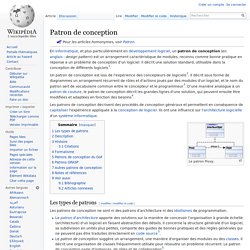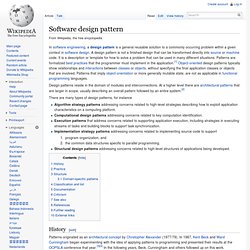

Patron de conception. Un article de Wikipédia, l'encyclopédie libre.

Pour les articles homonymes, voir Patron. En informatique, et plus particulièrement en développement logiciel, un patron de conception (en anglais : design pattern) est un arrangement caractéristique de modules, reconnu comme bonne pratique en réponse à un problème de conception d'un logiciel. Il décrit une solution standard, utilisable dans la conception de différents logiciels[1]. Les patrons de conception décrivent des procédés de conception généraux et permettent en conséquence de capitaliser l'expérience appliquée à la conception de logiciel. Ils ont une influence sur l'architecture logicielle d'un système informatique.
Les types de patrons[modifier | modifier le code] Les patrons de conception ne sont ni des patrons d'architecture ni des idiotismes de programmation. Description[modifier | modifier le code] Les patrons servent à documenter des bonnes pratiques basées sur l'expérience. Histoire[modifier | modifier le code] Adapter Bridge Builder. Software design pattern.
There are many types of design patterns, for instance Algorithm strategy patterns addressing concerns related to high-level strategies describing how to exploit application characteristics on a computing platform.Computational design patterns addressing concerns related to key computation identification.Execution patterns that address concerns related to supporting application execution, including strategies in executing streams of tasks and building blocks to support task synchronization.Implementation strategy patterns addressing concerns related to implementing source code to support program organization, andthe common data structures specific to parallel programming.Structural design patterns addressing concerns related to high-level structures of applications being developed.

History[edit] Although design patterns have been applied practically for a long time, formalization of the concept of design patterns languished for several years.[5] Practice[edit] Structure[edit] Criticism[edit] Ajax Design Patterns - Michael Mahemoff. Inversion of Control Containers and the Dependency Injection pattern. In the Java community there's been a rush of lightweight containers that help to assemble components from different projects into a cohesive application.

Underlying these containers is a common pattern to how they perform the wiring, a concept they refer under the very generic name of "Inversion of Control". In this article I dig into how this pattern works, under the more specific name of "Dependency Injection", and contrast it with the Service Locator alternative. The choice between them is less important than the principle of separating configuration from use. One of the entertaining things about the enterprise Java world is the huge amount of activity in building alternatives to the mainstream J2EE technologies, much of it happening in open source. A lot of this is a reaction to the heavyweight complexity in the mainstream J2EE world, but much of it is also exploring alternatives and coming up with creative ideas. Components and Services A Naive Example class MovieLister...
S blog: Handling Plugins In PHP. These patterns are designed to handle communication between disjoint objects.

Now, one key point to note here, is that every listener would need to bind to the object instance that it wants to track. Another key point is that the Subject does not pass along any information about the cause of the update. This makes the Observer Pattern extremely useful for situations where you want to bind the state of one part of the application to the state of another. A key example of this is in a stateful MVC pattern, you can bind a view instance to observe a model instance. That way, when a controller makes changes to that model instance, it will notify all the views that are listening that it changed and they need to re-render themselves. However, it should also be noted that the Observer Pattern creates a moderate coupling between the two classes involved (the subject and the observer) as they need to directly call methods on each other. Mediator Pattern A quick example: Functional Handlers An example: